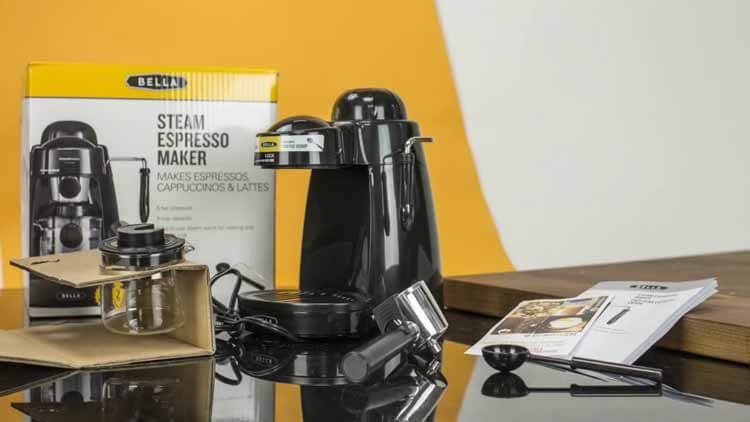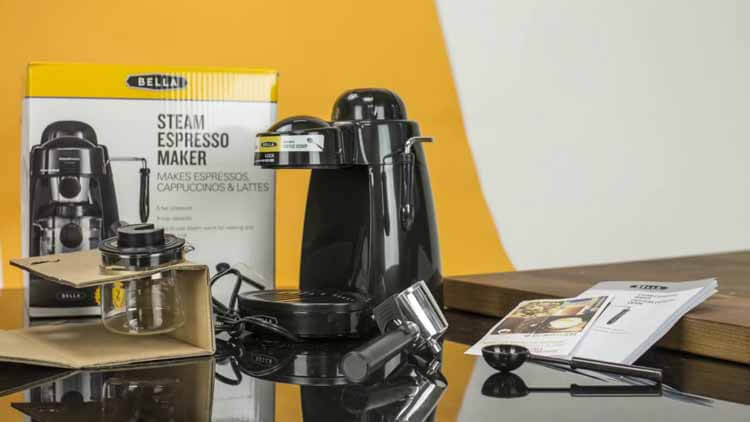
Coffee is something you cannot start your day without. And buying your favorite cappuccino or latte from the corner Starbucks every day, you wonder it’s probably better to get a coffee maker at home.
Yes, you are right. And you are planning on getting an espresso machine, good for you! Now, before you start browsing through all the machines online, spare a few minutes, and learn about the basics first.
In this article, we are going to show you how to use a steam espresso machine. Read ahead and see how easy it is to save those few bucks every day!
Types of Espresso Machine
From the first original coffee maker to the most modern one-switch ones, espresso machines have come a long way. And if you browse through the coffee machine types, you will see no one type is better than the other. Of course, that calls for a debate.
But seriously, each one has its perks and is equally popular. And these wide ranges of makers fall into two categories. Let’s have a quick look at them before getting into the discussion of how to use a steam coffee maker.
Steam Driven Makers
The steam machine is the first-ever invented espresso machine. It was first invented in 1884, and to this day, it is one of the easiest to use. The mechanism is simple, and the compact design doesn’t take much of your countertop space.
So, how does it work? Well, it has an air-tight boiler that you need to fill manually. Within the boiler, water is heated to the boiling point, and then it pressure-passes the hot water through the fine ground coffee in the portafilter. As the water is boiled, it creates steam, which in turn generates pressure.
Today’s steam machines come with a steam wand that you can use to steam or froth the milk.
With the simple mechanism, these makers make a suitable option for home use. However, they fall short on generating enough pressure for a concentrated espresso shot. And you also have to be careful with the boiler, which will be heating the water constantly.
Pump Driven Makers
The pump-driven espresso machines are the widely used ones nowadays. And you see them everywhere, whether it’s a local coffee shop or an expensive hotel.
The reason being is that they are the most practical ones. With no boiler and steam, the water pressure is created by a pump. Again, there is a lot of variety in the machine, depending on the functionality and pump type.
These superior engineered machines are great for maintaining the consistency of the coffee. And they come with features like temperature and pressure adjustment. Depending on the additional features, the price also varies in a wide range.
With an attached water source, controlled water pressure, and temperature, the barista has a lot less to do. Nevertheless, based on the human effort needed, pump-driven espresso machines can be super-automatic, automatic, and semi-automatic.
The first one being most automated, needs the minimum effort as it grinds, extracts, and stops on its own. Some of the machines come with a self-cleaning function as well. With such high-end features, they are the most expensive.
Although the one push button lets you make coffee effortlessly, it offers very little room for you to enhance your coffee creativity.
And the semi-automatic ones require a little effort on your part as it only does the job of boiling the water and pressure pumping it. And you need to do the rest; measure the coffee amount, tamp it, and control the water volume.
The machine is most coffee lovers’ favorite as it lets the operator be creative and experiment with the type and amount of coffee, water volume, tamping, and many more.
How to Use a Steam Espresso Machine?
The steam espresso machines, being the most affordable ones, are the best fit to have at home. And once you have decided on getting one, you can’t help being excited to use it.
So, check out the basic steps to use a steam espresso machine.
Plug-in and Set-up
Don’t just start using the machine right away. Instead, read the manual first and know about all the parts. Once you are acquainted with all the pieces, plug in your machine.
Now unscrew the knob on the boiler. Most machines have an aluminum boiler with a thermal plastic cover on it. Fill it with water and run some dry test without using any coffee. This will help you better understand the device.
Brew Coffee
For brewing, take the measured amount of fine ground coffee in the portafilter. Use a tamp and apply sufficient pressure on it to compact the coffee. However, don’t tamp too much; otherwise, you may see no espresso coming out while brewing.
Attach the portafilter filled with coffee grounds to the group-head and turn on the machine. Wait for some time, and you will hear a whirling sound from the machine that indicates water is boiling up, and the pressure is building inside.
And once the water is heated, you will see beautiful brown espresso coming out of your machine into the mug placed beneath the holder.
Steam Milk
Most people like to steam the milk first and then brew the coffee. Steaming the milk before or after doesn’t make a difference. Nevertheless, you can try both.
The machine has a steam wand on one side with a switch or lever. So after the water is heated, if you turn on the switch or pull the lever, you will see the steam coming out of it. However, we recommend you keep it turned on for a few seconds, to let the water trapped inside the wand come out.
Now take milk in a pitcher and put the steaming wand into it. Turn it on, and again you will hear the steam sounds. You can check the temperature increase with a thermometer or simply check with your hand. If you feel the pitcher getting heated enough, turn it off.
Mix It Up
As your milk is ready, pour it over the brewed espresso shot gently. And your coffee is ready. You can make unique arts on your latte or cappuccino if you want.
After you finish using the machine, make sure you don’t touch the hot boiler and wand with bare hands. The temperature is high enough to burn your hands. Keep it turned off for a while to let it cool.
Cappuccino or Latte?
Cappuccino and latte, two very similar forms of coffee, yet taste very different. And it’s the steaming mechanism of the milk that creates the difference.
While making cappuccino, you froth the milk keeping the steam wand half inches inside the milk surface. Frothing creates microbubbles and foams, which increases the volume of the milk.
For making a latte, the steam wand is kept more than half an inch inside the milk. This creates less foam and bubbles. The resulting milk is called steamed milk, which has fewer microbubbles than frothed milk.
Related article: How to Use Espresso Capsules without Machine
Wrapping Up!
So, that was all about how to use a steam espresso machine. The “original” coffee machine is not very hard to use. In fact, it’s the maker’s simplicity that has made the space for it among all the high-end espresso machines in today’s market. So, check it out, and enjoy making coffee at home.

